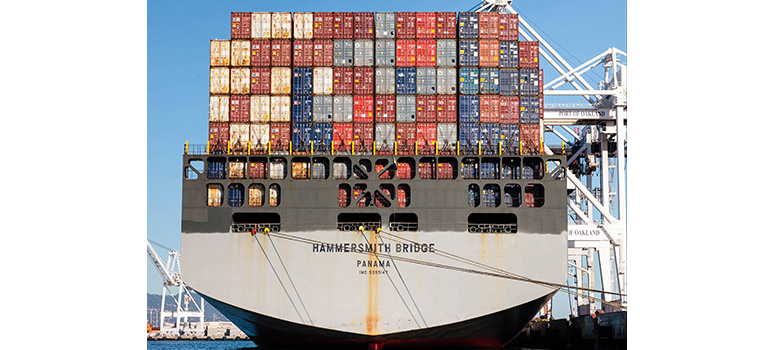All three of California's biggest ocean cargo gateways staged their annual "State of the Port" addresses last month, telling stakeholders that robust throughput numbers reached historic highs over the past year.

Although the Port of Oakland hit a second straight year of record volume, California ports lost five percent of all North American container market share due to stricter regulations. Photo courtesy of Port of Oakland
Published: February, 2019
All three of California’s biggest ocean cargo gateways staged their annual “State of the Port” addresses last month, telling stakeholders that robust throughput numbers reached historic highs over the past year.
The state’s third largest port, the Port of Oakland, got things underway first in early January, noting that it had handled the equivalent of 2.55 million twenty-foot equivalent units (TEUs) last year, which was up 5.2 percent from the port’s 2017 volume. Furthermore, it was the second straight year of record volume.
According to port figures, 2018 import cargo volume increased 5 percent while exports declined 3.5 percent. The volume of empty containers returned to origin destinations for future import loads increased 19.7 percent.
Port spokespeople told Working Waterfront that multiple influences were at work in 2018 shaping cargo flows, including:
• A China-U.S. trade dispute that prompted shippers to accelerate import orders ahead of anticipated tariffs;
• A strong dollar that made U.S. exports costlier overseas; and
• A buildup of empty containers in the U.S. that required repositioning to Asia because of the import surge.
“Last year was the busiest one ever at the port for a variety of reasons,” said Port of Oakland Maritime Director John Driscoll. “Our objective now is to build on this performance to grow import and export volume.”
Port of Long Beach Executive Director Mario Cordero weighed in a week later, updating the industry and community on major infrastructure projects, cargo trends, jobs, security and other major achievements in 2018, along with plans for the port in 2019. Long Beach Board of Harbor Commissioners President Tracy Egoscue also chimed in with a bullish forecast.
Meanwhile, the Port of Los Angeles moved more cargo in 2018 than any time in its 111-year history, racking up 9,458,749 TEUs, 1.2 percent more than 2017’s record-breaking year. It is the third consecutive year of record volumes for the nation’s number-one gateway for containerized trade and the most cargo moved annually by a Western Hemisphere port.
“The Port of Los Angeles continues to be a national leader in cargo volume and innovation,” said John McLaurin, President of the Oakland-based Pacific Merchant Shipping Association (PMSA). “These record volumes are a reflection of the dedication and hard work of the port and all of the supply chain partners.”
But McLaurin also shared some cautionary advice for shippers this year, noting that California’s unstable political environment and regulatory constraints could tarnish these rosy prognostications.
“International trade accounts for one out of nine jobs in Southern California, plays a vital role in the Bay Area economy, and provides the infrastructure for California companies to export products to other states and countries,” he said in recent blog post shared with Bay Crossings. “However, significant issues need to be addressed by Governor Newsom for California to preserve or enhance its competitive position in international trade.”
He further noted that California is losing market share to eastern, Gulf and Canadian ports. In fact, California’s ports have lost 5 percent of all North American container market share—dropping from 35.5 percent to 30.2 percent and current volume numbers are nearly 50 percent below state projections. This amounts to lost opportunities for the state in terms of jobs, personal income and state and local revenues.
“Those that import cargo through California cite higher costs associated with regulations, and increased uncertainty with regard to constantly changing environmental regulations and associated costs as the motivations for re-routing goods,” said McLaurin.
For Bay Area shippers, the most disconcerting part of this diversionary trend is that once supply chains are re-routed, they are notoriously hard to reverse. “As a result, California’s loss of port, warehouse, trucking and rail jobs, and the associated state and local tax revenues, go to our competitors,” said McLaurin.
McLaurin also noted that those cargo diversions also result in higher greenhouse gas emissions for the planet and leave those who have invested heavily in cleaner operations here in California without the additional revenues necessary to offset the higher costs.
Patrick Burnson is the executive editor of Logistics Management. www.logisticsmgmt.com

